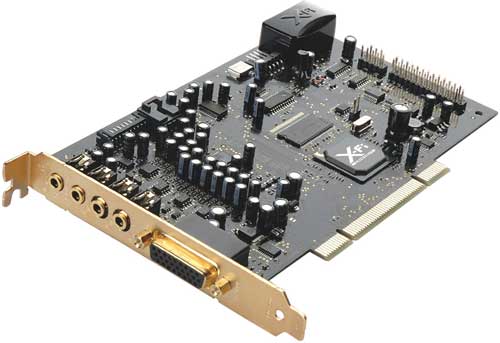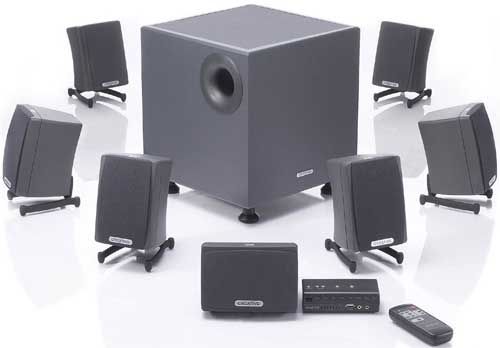The Business of Technology: Creative Labs
by Ryan Smith on October 2, 2007 5:00 PM EST- Posted in
- Bulldozer
Creative's Technology
So what has brought upon these changes in revenue and Creative's overall business problems? The answer to that lies in what's been going on with their technology and individual product market share.
Earlier we called Creative the king of sound cards until recently, much of their business woes stems from that loss. Creative's history is one founded on the back of the Sound Blaster hardware and the Sound Blaster name, creating a problem for Creative in having all of their eggs in one basket that they have been trying to solve for years. All told, Creative hasn't had a lot of luck spreading out their business and doing well; various efforts like graphics cards and DVD-ROM drives never panned out. Of the few things that have panned out, Creative's major consumer product lines have settled in as the following: portable media players, sound cards, webcams, and speakers.
Since sound cards were Creative's biggest business at one point, it has been Creative's biggest loss. Onboard audio has gone from a joke 10 years ago to how the vast majority of computers today handle audio, and it has been Creative who has suffered the greatest losses from that. The Live and Audigy series have both been bonafide successes in terms of sales, but never the less sales are slowing and the X-Fi likely won't be nearly as successful. The fact of the matter is that the consumer sound card market is on its last leg and the possible user base for such hardware has shrunk to professionals and gamers, and that's it.

The X-Fi will likely be the last significant feature-heavy sound DSP to be released by anyone, and it will never match the kinds of sales Creative has seen with earlier products. The final nail in the coffin will be Windows Vista, which as we have discussed in our review of that operating system, under normal circumstances runs the entire audio subsystem in software, reducing the need for a sound card down to a DAC to handle the digital/analog conversion. Creative's own troubles in writing solid Vista drivers for their sound cards hasn't helped matters either, but this has only hastened the inevitable. The sound card is dead, and it isn't coming back.
So what is Creative's leading product with the demise of the sound card? As we saw in their financials, it's now portable media players, a growing market but unfortunately for Creative it's one that they're getting slaughtered in. Prior to the arrival of the iPod, Creative was vying for the top of the portable media player market next to the now-defunct Rio brand, leading to the infamous Slashdot quote about the iPod's release: "No wireless. Less space than a nomad. Lame." Now Creative is struggling in a market where it was one of the first players.

Apple has the vast majority of the North American market for obvious reasons, but #2 tends to be shocking to most people: SanDisk. With Apple's main focus on the mid-to-high end MP3 player market, it has left an opening for cheap media players that SanDisk has been able to fill. Meanwhile both SanDisk and Apple have kept Creative and the other competitors locked out of the market, with Creative taking the #3 spot with less than 4% of the market. Creative's problems are further compounded by Microsoft at #4, who is more than happy to lose money on the media player market for now, and previously backed the PlaysForSure technology that Creative uses for DRM. It should be noted however that Apple doesn't have this kind of penetration in Asia, but as there are no reliable statistics on sales in most Asian markets, we can't ascertain what Creative's exact share there is, but it's believed to still be well below #1.
As a result of all of this, what little share of the market Creative has is almost entirely composed of the near-commodity market, save the small number of "anything but Apple" sales. Their Nomad and Zen lines do not have any significant brand recognition, meanwhile SanDisk can build & sell flash based media players for less than Creative. What little bit of the near-commodity market Creative does have a strong foot in is hard drive based media players that focus on video, and even this is at risk of being undermined by Apple now that they have a full-screen iPod to compete. In spite of all of this the majority of Creative's revenue comes from portable media player sales, but fighting on the near-commodity market means they will never be able to attain much of a profit with it.
Creative's third market segment, webcams, is more or less the same story. Webcams are a commodity - there's a lot of competition and not a lot of money. They may stay in it, but they'll never be able to repeat their most profitable days relying on webcams.
There is one bright spot for Creative however, and that's speakers. In their efforts to branch out Creative picked up Cambridge Soundworks in 1997, and their speaker division has continued to perform well. Creative is only dealing in computer speakers which limits their overall market and they face stiff competition from the likes of Logitech, but this market isn't quite a commodity market like Creative's other major markets. In fact as a percentage of revenue the speaker division is nearly 20%, which is itself nearly twice as much as it was 2 years ago. We'd expect Creative to be pushing their speaker products harder as the sound card market finishes crashing, since even with the integration of audio consumers still need speakers.

Finally there are all of Creative's other markets, which we'll touch on briefly. Creative continues to sell various peripherals, such as mice and routers, but most of these are low-volume products that are simply rebranded products form other suppliers. In fact most readers have probably never seen these products in a local store; Creative's minor product lines are almost exclusively limited to the Asian markets. The profitability from these operations is reportedly decent, but it's not something that Creative can win at in the international markets.










95 Comments
View All Comments
Sunrise089 - Tuesday, October 2, 2007 - link
I'm no expert, but it seems like there are three things they could do to turn thing around:1) Market their MP3 players better. I know several people who aren't in the "anything but apple" crowd, but who insist everything other than styling and interface is better in the Creative MP3 players. I'm sure more than 4% of the market would choose better audio quality if they could get it, so that's what Creative needs to be advertising.
2) Make the X-fi's cheaper, and market them to gamers. The serious music crowd already has an X-fi if they want one. Gamers however like extra FPS, and I've seen plenty of benches showing decent gains for add-on audio. At the very least gamers should buy an X-fi before a RAID0 setup.
3) Move into the on-board market. Creative still has a better association with quality than Realtec. So I'd have to think there would be some potential for moing the low-end of their soundcard market from discreet to integrated options.
heated snail - Tuesday, October 2, 2007 - link
Back in 1999-2000, two Soundblaster Live audio boards completely failed to work with my via-based AMD platform running first Windows 98, then ME, then 2000. Sound was present but there were regular blue-screens caused by the audio driver. Creative first denied any problem, then blamed VIA's PCI latency issues. Those issues were true, but the daily crash was still in Creative's drivers. Further customer service (or even official response to the issue on their joke of a support website) was nonexistent.Since that time I have eagerly hoped for other consumers to see through Creative's blend of extremely heavy advertising budget and extremely lightweight customer service and support. Their formula worked for years, and now maybe it's almost finished. Creative, rest in pieces.
DigitalFreak - Tuesday, October 2, 2007 - link
Good riddance to bad rubbish. If it wasn't for almost exclusive support of EAX in games, their soundcard division would have died a long time ago. Now all we need is a positional sound open standard (OpenAL is still a Creative controlled standard).As much as I dislike Vista, I have to give props to Microsoft for single handedly killing EAX. :0)
cambit69 - Tuesday, October 2, 2007 - link
in some ways, Creative Labs reminds us of Eastman Kodak company. They missed the boat on digital cameras because they refused to acknowledge that digital would replace film (film was what the company was knwon to have pioneered). THe same way how Creative Labs just sat on their tried and true Sound Blaster brand and refused to put R&D into newer technologies and branch out.creative put 7% of their total revenue into R&D, that doesnt sound a lot to me for a business that relies on technology and it makes me wonder where the other 93% of their revenue is going.
The Boston Dangler - Wednesday, October 3, 2007 - link
your analogy would better fit Polaroid. Eastman Kodak is alive and very well, Polaroid would be dead if it weren't for a couple industrial things going on.strikeback03 - Wednesday, October 3, 2007 - link
Kodak is alive, very well is a different story. Almost all of their products compete at the low end of the point&shoot market, where the competition is fierce and margins small. It is analogous to the segment of the MP3 player market Creative competes in. Kodak's last adventure with a dSLR did not go well, and if they were to re-enter that market it would likely need to be as a partner to someone, as they don't have their own line of lenses and other accessories, which are where the real money is in the dSLR world.Duwelon - Tuesday, October 2, 2007 - link
I haven't read much on UAA, why does the article say the sound card is going away and won't be coming back?What is UAA that it makes hardware based positional audio obsolete?
saratoga - Tuesday, October 2, 2007 - link
I'm no expert on it (never did any Windows driver development), but its basically a standard for audio cards that moves most of the processing into standard Windows components that run in user mode.The upside of this is that sound cards will be able to work correctly and provide a high degree of functionality (5.1, etc) with no extra drivers at all (think how USB flash drives work without a driver disk). Additionally, since they run in user mode, bad drivers will no longer be able to BSOD Windows, at worst the app would crash to the desktop. Presumably, the ultimate goal is for MS to move audio processing over to more standard multicore and onboard accelerators (built in GPUs/PPUs/etc) rather then expensive and less functional proprietary PCI devices.
This really screws over Creative of course, since effectively MS is putting their sound card business out to pasture. I can't say I blame them though. After all the stuff Creative's pulled, MS clearly wants to get them as far from their OS as possible.
leexgx - Wednesday, October 3, 2007 - link
it can still be done in hardware but its more standardised
there drivers still suck and thay Refuse to support OEM sound cards that CAN ONLY be made by creative (it be like nvidia saying we not going to support an BFG NVida video card coes it has an badge on it that says BFG)
EarthsDM - Tuesday, October 2, 2007 - link
...fast enough. The soon they are gone, the better. They started a real revolution, and then drove their popularity into the ground.